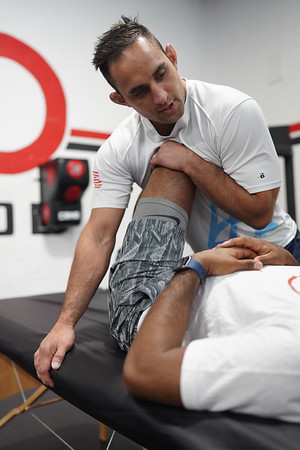
What is PT?
What does it help with?
Physical therapy is a mode of treatment that addresses functional impairments. For sports physical therapists, these impairments usually include injury to the neurological or musculoskeletal systems. Injuries often result in loss of movement, muscle weakness, or avoidance of sporting activity that aggravates the pain. Athletes often discuss pain and fear of training or competing as their primary concerns.

How does it “work”?
Physical therapy begins with a formal examination and evaluation. This includes history taking, movement assessment, systems evaluation and discussion of the examination findings. Based on your specific injury or condition, the physical therapist will develop a plan of care based on agreed upon goals. These can include things like running (football, soccer players), jumping (volleyball, basketball) or weightlifting (power lifters, crossfit). It is important you discuss what your goals are with the physical therapist; the reasons why you’re seeking treatment, and the level of activity you want to achieve. These goals should be specific (I can participate in 45 of the 60 minutes of play), measurable (I can now run for x miles), achievable (I want to get back to my 6 minute mile for cross country), relevant (catching a pass in football) and time bound (I want to achieve this in 2 months, before competition season).
What you should know (treatment options)
There are several treatment models available within the context of physical therapy. These skill sets vary from therapist to therapist and may only be available in specific states. Some treatment options may be injury or sport specific, some may work well for your teammate, but not very well for you. The aim then, is to match your injury with the skill set of the therapist. Some treatment options include manual therapy (joint mobilizations, massage), dry needling, stretching, cupping or strength training (resistance, aerobic fitness). Usually a combination of the above mentioned treatments are required to get you moving in the right direction. It is best if you discuss these treatment options with the therapist after your evaluation. Treatment options should always consider what you prefer (given that it is effective) and what is available (your PT has the skillset).
What to expect (improvements in dysfunction)
Seeking treatment from a physical therapist should always be done with a specific goal (or goals) in mind. Are you going to therapy because you have knee pain when you squat? Do you find yourself avoiding squatting and now have to substitute exercises, resulting in difficulty in other athletic activities? While pain management ought to be discussed, so should activity modification. Oftentimes, I advise patients to modify their current training while we teach techniques to manage pain. Just like learning a technical skill in sport, so too, should you be learning how to independently manage pain to improve function. While “hands on” therapy helps, creating a plan of care with independent exercises builds confidence that you are capable of managing pain. This sets the athlete up for success. What happens if they’re traveling to a different country and you have no access to hands-on treatment? Get on that home exercise program! You should expect consistent improvement in pain, dysfunction and confidence with sporting activities. Communication with your therapist is very important! Discuss where you’re at now and where you want to go. Discuss your timeline, how often you train, what type of training you engage in, length of training sessions, how often you compete, what the demands of competition are, how you communicate with coaches etc… All pieces of the puzzle should be considered. An effective therapist is one that pays attention to what YOU need as an athlete.